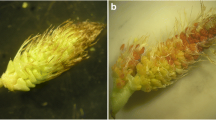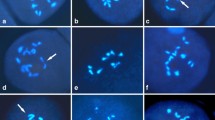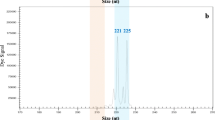Abstract
Interspecific hybrids often produce extensive gametic variation due to poor chromosome pairing and unbalanced chromosome segregation. To elucidate the influence of interspecific hybridisation on pollen variation in Populus L., we compared pollen size among three P. deltoides Marsh. clones, two P. nigra L. clones, and three P. deltoides × P. nigra hybrids and investigated the cytological mechanism of pollen variation by observing meiotic chromosome behaviour and microtubules. The frequency of shrunken and unstainable pollen grains was higher in the hybrids (15.54–57.28 %) than in the non-hybrid clones (0.98–4.82 %). The distribution of stained pollen size ranged more broadly in the hybrids than in the non-hybrids, suggesting that hybridisation increases pollen size variation. Precocious chromosome migration and lagging chromosomes were common in the hybrids, indicating poor chromosome pairing. Some micronuclei formed minispindles in metaphase II and emanated secondary nuclear-based radial microtubule systems in telophase II, undergoing cytokinesis to develop into microcytes in the meiotic products. Eliminated micronuclei might result in the formation of aneuploid pollen. The frequency of sporads with microcytes was higher in the hybrids (3.19–11.08 %) than in the non-hybrids (0–0.94 %). Disoriented spindles, including fused and tripolar spindles, led to the formation of dyads and triads, contributing to unreduced pollen production. These results provide new insights into the gametic variation of Populus interspecific hybrids and reveal several 2n pollen producers, which will be valuable in polyploid breeding of the section Aigeiros Duby.



Similar content being viewed by others
References
Abbott R, Albach D, Ansell S et al (2012) Hybridization and speciation. J Evol Biol 26:229–246
Bednara J, Gielwanowska I, Rodkiewicz B (1986) Regular arrangements of mitochondria and plastids during sporogenesis in Equisetum. Protoplasma 130:145–152
Bradshaw HD Jr, Stettler RF (1993) Molecular genetics of growth and development in Populus. I. Triploidy in hybrid poplars. Theor Appl Genet 86(2–3):301–307
Bretagnolle F, Thompson JD (1995) Gametes with the somatic chromosome number: mechanisms of their formation and role in the evolution of autopolyploid plants. New Phytol 129:1–22
Brown RC, Lemmon BE (2011) Dividing without centrioles: innovative plant microtubule organizing centres organize mitotic spindles in bryophytes, the earliest extant lineages of land plants. AoB Plants 2011:plr028
Brownfield L, Yi J, Jiang H, Minina EA, Twell D, Köhler C (2015) Organelles maintain spindle position in plant meiosis. Nat Commun 6:6492
Calderini O, Mariani A (1997) Increasing 2n gamete production in diploid alfalfa by cycles of phenotypic recurrent selection. Euphytica 93(1):113–118
Comstock RE, Robinson HF (1952) Estimation of average dominance of genes. Heterosis. State College Press, Ames (IA)
De Storme N, Geelen D (2011) The Arabidopsis mutant jason produces unreduced first division restitution male gametes through a parallel/fused spindle mechanism in meiosis II. Plant Physiol 155(3):1403–1415
De Storme N, Geelen D (2013) Sexual polyploidization in plants—cytological mechanisms and molecular regulation. New Phytol 198(3):670–684
d’Erfurth I, Jolivet S, Froger N, Catrice O, Novatchkova M, Simon M, Jenczewski E, Mercier R (2008) Mutations in AtPS1 (Arabidopsis thaliana parallel spindle 1) lead to the production of diploid pollen grains. PLoS Genet 4(11):e1000274
Einspahr DW (1984) Production and utilization of triploid hybrid aspen. Iowa State J Res 58:401–409
Erazzú LE, Camadro EL (2007) Direct and indirect detection of 2n eggs in hybrid diploid families derived from haploid tbr × wild species crosses. Euphytica 155(1–2):57–62
Farco GE, Dematteis M (2014) Meiotic behavior and pollen fertility in triploid and tetraploid natural populations of Campuloclinium macrocephalum (Eupatorieae, Asteraceae). Plant Syst Evol 300(8):1843–1852
Huang QJ, Zhang ZY, Kang XY (2002) 2n pollen of P. tomentosa × P. bolleana induced by four antimicrotubule agents. J Beijing For Univ 24(1):12–15
Kang XY, Zhu ZT, Zhang ZY (2000a) Breeding of triploids by the reciprocal crossing of Populus alba × P. glandulosa and P. tomentosa × P. bolleana. J Beijing For Univ 22:8–11
Kang XY, Zhu ZT, Zhang ZY (2000b) Suitable period of high temperature treatment for 2n pollen of Populus tomentosa × P. bolleana. J Beijing For Univ 22:1–4
Kaul MLH, Murthy TGK (1985) Mutant genes affecting higher plant meiosis. Theor Appl Genet 70(5):449–466
Li KY, Huang MR, Wang MX (1997) Study on Origin of Populus tomentosa Carr. Acta Phytotaxon Sin 35(1):24–31
Mallet J (2005) Hybridization as an invasion of the genome. Trends Ecol Evol 20:229–237
Mashkina OS (1997) The formation of unreduced pollen in Populus exposed to high temperatures and chemical mutagens. In: Borzan Z, Schlarbaum SE (ed) Cytogenetic studies of forest trees and shrub species. Croatian Forests, Inc. & Faculty of Foresty, University of Zagreb, Zagreb
Mashkina OS, Burdaeva LM, Belozerova MM, Vyunova LN (1989) Method of obtaining diploid pollen of woody species. Lesovedenie 1:19–25
Mason AS, Pires JC (2015) Unreduced gametes: meiotic mishap or evolutionary mechanism? Trends Genet 31(1):5–10
McKim KS, Hawley RS (1995) Chromosomal control of meiotic cell division. Science 270:1595–1601
Mock KE, Callahan CM, Islam-Faridi MN, Shaw JD, Rai HS, Sanderson SC, Rowe CA, Ryel RJ, Madritch MD, Gardner RS, Wolf PG (2012) Widespread triploidy in western North American aspen (Populus tremuloides). PLoS One 7(10):e48406
Mok DWS, Peloquin SJ (1975) Three mechanisms of 2n pollen formation in diploid potatoes. Can J Genet Cytol 17:217–225
Müntzing A (1936) The chromosomes of a grant Populus tremula. Hereditas 21:383–393
Nilsson-Ehle H (1936) Note regarding the gigas form of Populus tremula found in nature. Hereditas 21:372–382
Orjeda G, Freyre R, Iwanaga M (1990) Production of 2n pollen in diploid Ipomoea trifida, a putative wild ancestor of sweet potato. J Hered 81:462–467
Parrott WA, Smith RR (1984) Production of 2n pollen in red clover. Crop Sci 24(3):469–472
Parrott WA, Smith RR (1986) Recurrent selection for 2n pollen formation in red clover. Crop Sci 26(6):1132–1135
Rae AM, Street NR, Rodríguez-Acosta M (2007) Populus trees. In: Kole C (ed) Genome mapping and molecular breeding in plants, vol 7., Forest treesSpringer, Berlin, pp 1–28
Ramsey J, Schemske DW (1998) Pathways, mechanisms, and rates of polyploid formation in flowering plants. Annu Rev Ecol Syst 29:467–501
Seitz FW (1954) The occurrence of triploids after self-pollination of anomalous androgynous flowers of a grey poplar. Z Forstgenet 3(1):1–6
Silkova OG, Shchapova AI, Shumny VK (2011) Meiotic restitution in amphihaploids in the tribe Triticeae. Russ J Genet 47(4):383–393
Soltis PS, Soltis DE (2009) The role of hybridization in plant speciation. Annu Rev Plant Biol 60(1):561–588
Tuskan GA, Difazio S, Jansson S et al (2006) The genome of black cottonwood, Populus trichocarpa (Torr. & Gray). Science 313:1596–1604
Wang J, Kang X (2009) Distribution of microtubular cytoskeletons and organelle nucleoids during microsporogenesis in a 2n pollen producer of hybrid Populus. Silvae Genet 58(5/6):220–226
Wang J, Kang X, Zhu Q (2010) Variation in pollen formation and its cytological mechanism in an allotriploid white poplar. Tree Genet Genom 6(2):281–290
Wasteneys GO (2002) Microtubule organization in the green kingdom: chaos or self-order? J Cell Sci 115(7):1345–1354
Yakimowski SB, Rieseberg LH (2014) The role of homoploid hybridization in evolution: a century of studies synthesizing genetics and ecology. Am J Bot 101(8):1247–1258
Younis A, Hwang YJ, Lim KB (2014) Exploitation of induced 2n-gametes for plant breeding. Plant Cell Rep 33(2):215–223
Yu HG, Dawe RK, Hiatt EN (2000) The plant kinetochore. Trends Plant Sci 5(12):543–547
Zhang Z, Kang X (2010) Cytological characteristics of numerically unreduced pollen production in Populus tomentosa Carr. Euphytica 173(2):151–159
Zhang S, Qi L, Chen C, Li X, Song W, Chen R, Han S (2004) A report of triploid Populus of the section Aigeiros. Silvae Genet 53:69–75
Zhang Z, Kang X, Zhang P, Li Y, Wang J (2007) Incidence and molecular markers of 2n pollen in Populus tomentosa Carr. Euphytica 154:145–152
Zhang JF, Wei ZZ, Li D, Li B (2009) Using SSR markers to study the mechanism of 2n pollen formation in Populus × euramericana (Dode) Guinier and P. × popularis. Ann For Sci 66(5):506
Zhu ZT, Lin HB, Kang XY (1995) Studies on allotriploid breeding of Populus tomentosa B301 clones. Sci Silvae Sin 31:499–505
Zhu ZT, Kang XY, Zhang ZY (1998) Studies on selection of natural triploid of Populus tomentosa. Sci Silvae Sin 34:22–31
Acknowledgments
We thank the Forestry Research Institute of Tongliao City in the Inner Mongolia Autonomous Region, Yining Plain Forest Farm in Xinjiang and Beijing Botanical Garden, P. R. China, for providing plant materials. This work was supported by Program for New Century Excellent Talents in University (Grant No. NCET-13-0672), a Foundation for the Author of National Excellent Doctoral Dissertation of P. R. China (Grant No. 201267), the 111 Project (Grant No. B13007) and the Beijing Nova program (Grant No. Z141105001814007).
Author information
Authors and Affiliations
Corresponding author
Additional information
Ju Tian and Junhao Wang have contributed equally to this work.
Rights and permissions
About this article
Cite this article
Tian, J., Wang, J., Dong, L. et al. Pollen variation as a response to hybridisation in Populus L. section Aigeiros Duby. Euphytica 206, 433–443 (2015). https://doi.org/10.1007/s10681-015-1507-z
Received:
Accepted:
Published:
Issue Date:
DOI: https://doi.org/10.1007/s10681-015-1507-z




